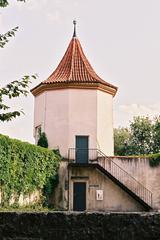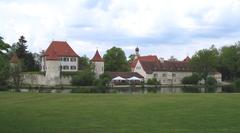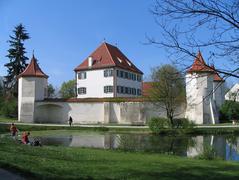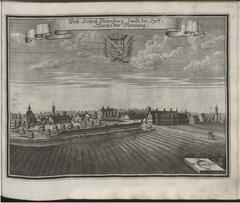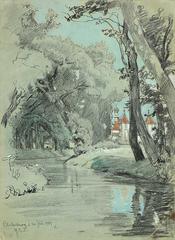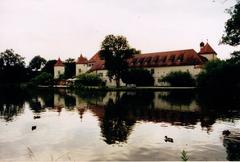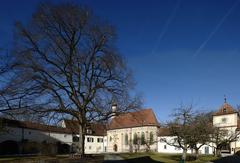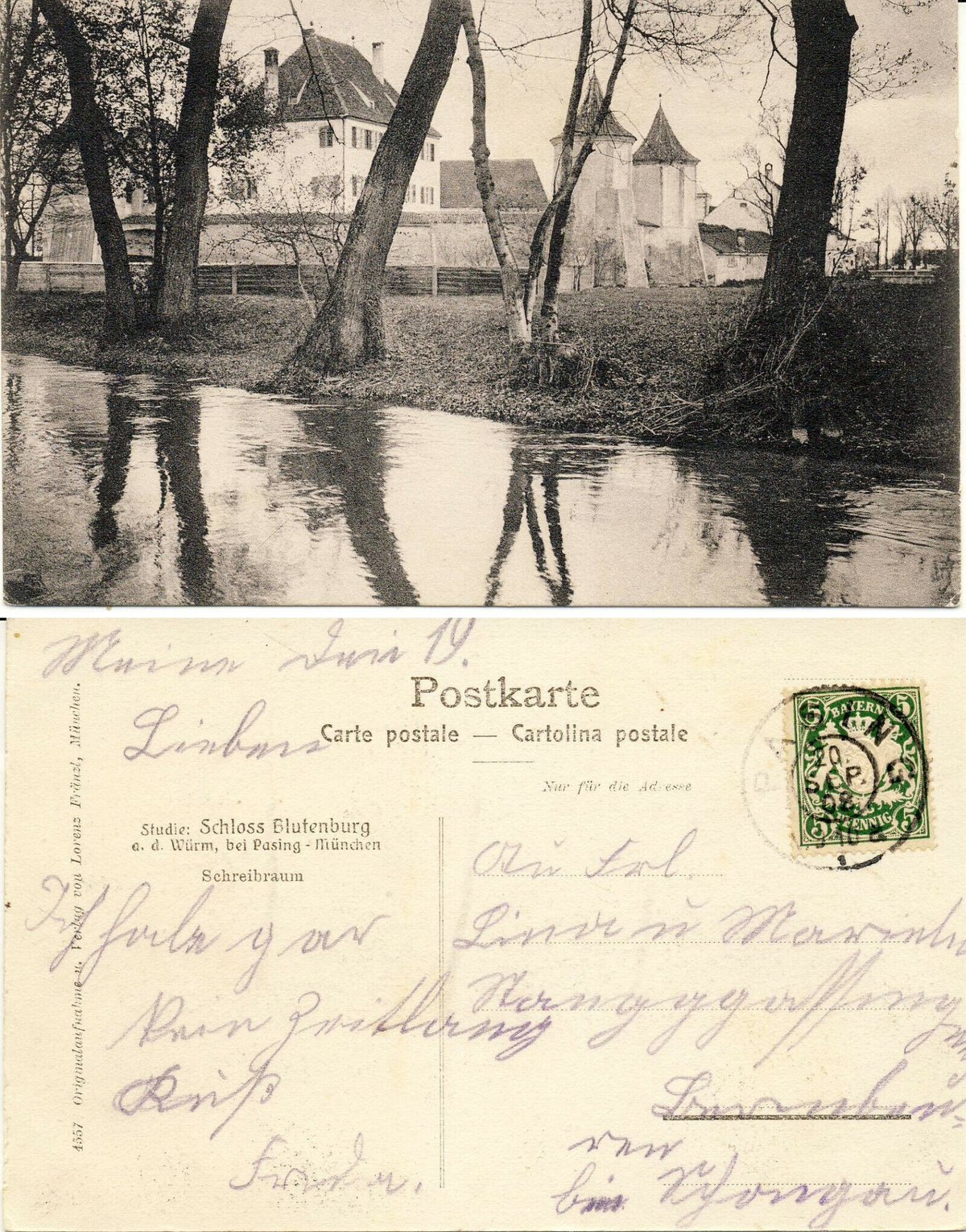
Blutenburg Castle: Visiting Hours, Tickets & Historical Highlights in Munich
Date: 14/06/2025
Introduction
Blutenburg Castle (Schloss Blutenburg) stands as one of Munich’s most captivating historical landmarks, nestled in the idyllic district of Obermenzing, northwest of the city center. Originally commissioned in the early 15th century by Duke Albrecht III of Bavaria as a moated hunting lodge and residence, Blutenburg Castle uniquely blends medieval defensive architecture with later Baroque enhancements (muenchen.de; SpottingHistory). Its picturesque setting along the River Würm, enveloped by tranquil parklands and a reflective moat, makes it a serene escape and a window into Bavaria’s cultural evolution.
Today, Blutenburg is not only a testament to Bavarian history and architectural artistry but also a vibrant cultural hub. It is home to the International Youth Library— the world’s largest of its kind— offering an exceptional literary resource and hosting dynamic cultural events for visitors of all ages (blutenburg.de; theshwits.com). This guide provides all the essential details for visiting Blutenburg Castle, including historical context, practical information on hours and tickets, highlights of the castle’s architectural and artistic treasures, and tips for making the most of your visit.
Table of Contents
- Historical Overview
- Artistic and Architectural Highlights
- International Youth Library
- Visiting Information
- Nearby Attractions
- Frequently Asked Questions (FAQ)
- Summary and Tips
- Sources
Historical Overview
Medieval Origins and Construction
Blutenburg Castle’s story began in the early 15th century, first documented in 1432 during a period of territorial expansion in Bavaria. Duke Albrecht III commissioned its construction in 1439, selecting a strategic location between two arms of the River Würm. The castle was designed as a fortified hunting lodge and noble residence, featuring a defensive moat, ring wall, gate tower, and ancillary farm buildings (muenchen.de; destination-munich.com). This robust medieval layout is still visible in the preserved courtyard, towers, and moat.
Architectural Evolution
Blutenburg Castle’s architecture evolved over centuries. In 1488, Duke Sigismund added the late Gothic palace chapel, now one of Bavaria’s most intact medieval ecclesiastical interiors. After suffering damage during the Thirty Years’ War, the castle was rebuilt in 1681, incorporating Renaissance and Baroque elements that softened its military character and enhanced its residential comfort (awaymag.com).
Decline and Restoration
By the 16th century, the castle’s prominence waned and it fell into neglect, facing periods of disrepair and changing ownership. A major restoration from 1978 to 1983, led by cultural institutions, revitalized Blutenburg and repurposed it as a center for education and culture (blutenburg.de).
Artistic and Architectural Highlights
The Palace Chapel
A jewel of late Gothic art, the palace chapel is renowned for its original stained-glass windows, intricate ribbed vaulting, and exquisitely carved wooden altars. The main altar, attributed to Jan Polack (1491), depicts Saints Bartholomew and Sigismund and biblical scenes such as the Baptism of Christ (muenchen.de). A cycle of wooden statues of the apostles, created by the “Meister of the Blutenburger Madonna,” lines the walls, while side altars and sixteen stained-glass windows complete the ensemble (destination-munich.com; SpottingHistory).
Interior Spaces & Museum Exhibits
Inside, visitors can explore reconstructed residential quarters and reception halls featuring medieval inscriptions, heraldic emblems, and decorative motifs from various historical eras. Exhibition rooms display ceramics, antiques, and documents related to the castle’s history (Urtrips).
Castle Grounds and Park
The castle is set within manicured parklands with ancient trees, benches, and scenic lawns. Sculptures and remnants of the original moat and trench evoke the site’s defensive origins. The ambiance is especially magical in spring and autumn, with reflections shimmering on the water and vibrant foliage (Urtrips).
International Youth Library
Since 1983, Blutenburg Castle has hosted the International Youth Library (Internationale Jugendbibliothek), the world’s largest collection of children’s and youth books in over 130 languages (theshwits.com). The library organizes literary festivals, author readings, thematic exhibitions, and educational workshops, promoting intercultural understanding through literature. Themed rooms, such as the Michael Ende Museum and James Krüss Tower, and annual events like the White Ravens Festival, make the library a destination for families and literature lovers alike (Triphobo).
Visiting Information
Visiting Hours
- Castle Grounds: Open daily from 9:00 to 18:00 (Blutenburg Castle Visitor Info).
- International Youth Library: Tuesday–Friday: 10:00–16:00; weekends: 14:00–17:00; closed Mondays and public holidays.
- Palace Chapel: Open daily; closes at 5:00 pm in summer (April–September), 4:00 pm in winter (October–March).
Note: Hours may vary for special events and holidays. Always check the official website before your visit.
Tickets and Admission
- Castle Grounds & Library: Free entry.
- Museum/Exhibitions: €3 per person (discounts for students, seniors, and groups).
- Guided Tours: €5–€10 per person; advance booking recommended.
- Special Events: Some events may require separate tickets; see event listings.
Accessibility
The castle grounds and library offer paved paths and ramps for wheelchair users and strollers, but some historic interiors and upper floors may have limited access due to preservation constraints. The library provides multilingual materials and inclusive programming. Contact the site in advance for specific accessibility needs.
Guided Tours & Events
- Guided Tours: Available in German and English, lasting 60–90 minutes; explore the castle’s history, architecture, and the life of Duke Albrecht III (Blutenburg Castle Official).
- Cultural Events: Blutenburg hosts regular concerts, exhibitions, readings, and seasonal festivals. The annual Blutenburg Christmas Market is a highlight, transforming the grounds into a festive wonderland (Munich Christmas Markets).
Getting There & Amenities
- By Public Transport: S2 S-Bahn to Obermenzing, then a 15-minute walk or bus (lines 143, 160, or 162).
- By Car: Limited parking is available near the castle.
- Café and Restaurant: Enjoy Bavarian cuisine and cakes at Café Schloss Blutenburg with views of the moat.
- Gift Shop: Offers books, souvenirs, and locally crafted items themed around Bavarian culture and children’s literature.
- Restrooms & Wi-Fi: Modern amenities available near the entrance and within the library.
Nearby Attractions
- Nymphenburg Palace: Baroque palace and gardens, a short drive or transit ride away.
- Munich Botanical Garden: Extensive collection of plants adjacent to Nymphenburg Palace.
- Pasinger Stadtpark: Parkland perfect for walks and picnics.
- Pasing Arcaden: Shopping and dining center in the vicinity.
Frequently Asked Questions (FAQ)
Q: What are Blutenburg Castle’s visiting hours?
A: Castle grounds: 9:00–18:00 daily; Youth Library: Tuesday–Friday 10:00–16:00, weekends 14:00–17:00; Chapel closes at 5:00 pm (summer) or 4:00 pm (winter).
Q: Do I need tickets to enter?
A: Entry to the grounds and library is free. Museum, exhibitions, and guided tours require tickets (€3–€10).
Q: Is Blutenburg Castle accessible for disabled visitors?
A: The grounds and library are wheelchair accessible; some historic interiors may be limited. Contact in advance for details.
Q: Are guided tours available in English?
A: Yes, on weekends and public holidays; advance booking is recommended.
Q: Can I take photos inside?
A: Non-commercial photography is allowed in most areas. Tripods and drones require prior permission.
Q: Are pets allowed?
A: Leashed dogs are welcome on the grounds, but not inside buildings.
Summary and Tips
Blutenburg Castle offers a multifaceted visitor experience—combining medieval architecture, a unique literary collection, and a peaceful riverside park. Free entry to the grounds and library makes it an inviting destination for families, scholars, and tourists. Enhance your visit with a guided tour, enjoy seasonal festivals like the Christmas Market, and explore nearby cultural sites such as Nymphenburg Palace. For the most up-to-date information, consult the official website.
Travel Tips:
- Best Time to Visit: Spring, autumn, and December for the Christmas Market.
- Combine Your Trip: Explore the Würm River trails, Nymphenburg Palace, or Pasinger Stadtpark.
- Download the Audiala App: For guided tours and exclusive content on Munich’s historical sites.
Sources
- Blutenburg Castle Visiting Hours, Tickets, and History: Exploring Munich’s Historic Gem, 2025, Munich Tourism (muenchen.de)
- Blutenburg Castle Munich: Visiting Hours, Tickets & Architectural Highlights, 2025, SpottingHistory (SpottingHistory)
- Blutenburg Castle Visiting Hours, Tickets & Munich Historical Sites Guide, 2025, The Shwits (theshwits.com)
- Blutenburg Castle Visiting Hours, Tickets, and Munich Historical Sites Guide, 2025, Schloss Blutenburg Official (schloss-blutenburg.de)
- Blutenburg Castle Official Website, 2025 (blutenburg.de)
- Destination Munich: Blutenburg Castle, 2025 (destination-munich.com)
- Urtrips: Blutenburg Castle Munich, 2025 (Urtrips)
- Triphobo
- Munich Christmas Markets
- MVV Munich
- Bavarian State Department of Monuments

